Recent Articles
Popular Makes
Body Types
2025 Mazda CX-70 Road Test and Review
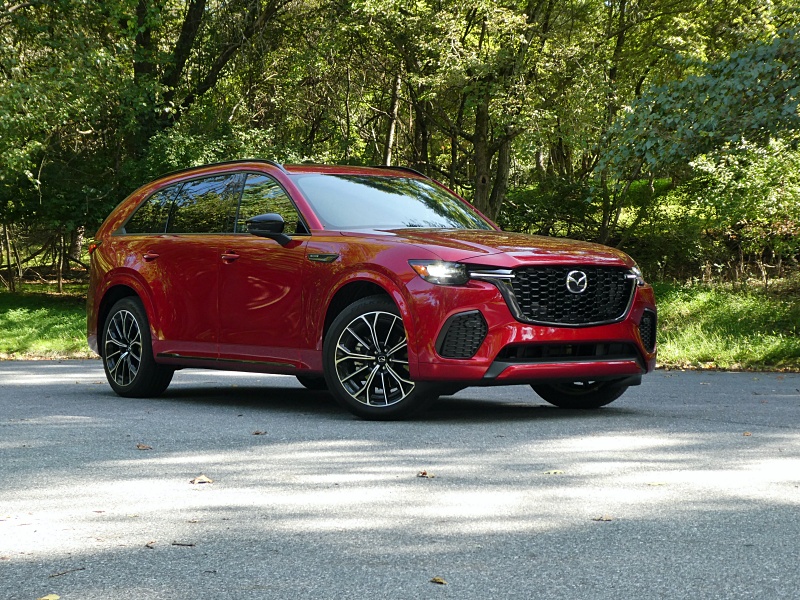
2025 Mazda CX-70 Turbo S ・ Photo by Brady Holt
The Porsche Cayenne is built as a sporty two-row mid-size SUV. The BMW X5, sometimes offered with a tiny third row, is currently sold only as a five-seater. And the all-new 2025 Mazda CX-70 wants to be considered among their ranks – with its rear-wheel-drive architecture, choice of powerful yet economical powertrains, and high-end interior finishes. Plus, with a base price of $40,445, it’s also a competitor to less exclusive models like the Volkswagen Atlas Cross Sport, Nissan Murano, Chevrolet Blazer, and Jeep Grand Cherokee.
To create the CX-70, Mazda took the eight-passenger CX-90 (which was new last year) and excised the final row of seats. Mazda fans had been looking forward to the idea of a smaller, lighter version of the acclaimed CX-90. Instead, Mazda decided to keep the CX-90’s dimensions for a bigger backseat and cargo hold than the CX-60 it sells in Europe. We just tested the CX-70 with both its gas engine and its plug-in hybrid powertrain to see what it brings to the table. Keep reading as we discuss its pros and cons so you can see if it’s the right mid-size crossover for you.
Upscale, Sporty Design
Any car can have stylistic details pointing to luxury and performance. But it’s hard work to create the proportions of a high-end vehicle. And Mazda put in that effort.
At a price point where most mid-size crossovers are front-wheel-drive boxes with turbocharged four-cylinder engines or naturally aspirated V6s, the CX-70 takes a page from BMW’s playbook. That’s a rear-wheel-drive platform and an inline six-cylinder engine, giving it a long nose with a short front overhang. That’s just not a look you can pull off with front-wheel drive, as a front-drive car typically has the engine forward of the wheels. (Every CX-70 has all-wheel drive, but its rear-drive-based architecture has the same result.) The CX-70 fits smoothly into the Mazda family, with small headlights astride a big grille. It doesn’t look cutting-edge-new, but we think it’s a great mix of sporty and classy.
However, just like its dimensions, the CX-70’s design is all but identical to the CX-90’s. A couple minor differences: the CX-70 has some color choices you won’t find on the CX-90; the CX-70 has black or gray exterior trim in some places where the CX-90 wears chrome; and the bumpers are slightly different. Fortunately, even the CX-90 is a great-looking premium mid-size SUV.
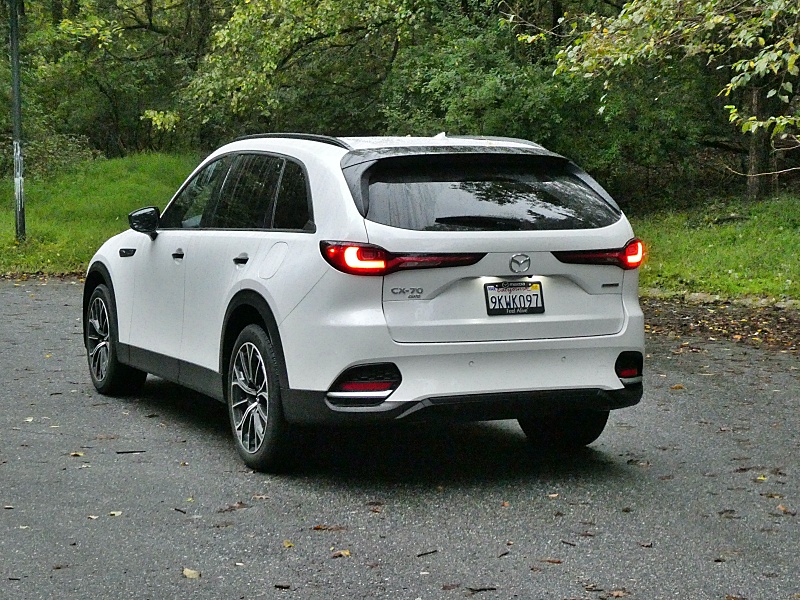
2025 Mazda CX-70 PHEV ・ Photo by Brady Holt
Sporty Driving Manners, Too
In addition to its styling advantages, the CX-70’s engineering choices allow for superior weight distribution. Combined with its taut suspension tuning, this makes the CX-70 more lively to drive than the typical competitor. It’s heavier and more solid-feeling than Mazda’s old front-wheel-drive-based CX-9, but thanks to the weight distribution, it’s still agile rather than feeling ponderous. And while the ride isn’t ultra-cushy, it’s comfortable and quiet. We wish the steering were lighter at parking-lot speeds, and some drivers might wish it were lighter at all times. And there’s no difference between how it drives versus the three-row CX-90. But we appreciated the CX-70’s performance aspirations.
The other key to the CX-70’s fun-to-drive nature lies under the hood, where each of the three available powertrains makes well over 300 lb-ft of torque. We’ll discuss that in a moment.

2025 Mazda CX-70 PHEV ・ Photo by Brad Holt
Choice of Three Powerful Powertrains
The base engine on the Mazda CX-70 is a mighty 3.3-liter inline six-cylinder turbo that makes 280 horsepower and 332 lb-ft of torque. That’s already better than most similarly priced crossovers. The available Turbo S models retune that engine to make 340 hp (or 319 hp if you stick with regular-grade fuel) and 369 lb-ft of torque. The Turbo S’s $6,000-plus upgrade fee is too steep for our tastes, but it’s still more affordable than a luxury-branded SUV.
Whether you get the standard turbo or the Turbo S, the 3.3-liter engine accelerates eagerly and sounds beautiful amid a sea of four-cylinder crossovers. And yet, it’s more economical than most similarly sized rivals – whether they have six cylinders or four, and whether they’re faster or slower than this high-speed Mazda. It gets an outstanding 24 mpg in the city, 28 mpg on the highway, and 25 mpg combined in EPA testing with the 280-hp engine and 23 mpg city, 28 mpg highway, and 25 mpg combined with the 340-hp version. We hit that average during our weeklong test.
What’s more, Mazda has a third option for eco-minded buyers: a plug-in hybrid (PHEV), which we’ll come to next.

2025 Mazda CX-70 Turbo S ・ Photo by Brady Holt
Plug It In
A PHEV is a cross between a conventional gas-electric hybrid and a fully electric car. It has an electric battery that you can recharge with electricity from the grid, and it also has a gas engine that can take over when you run out of juice or want to accelerate faster.
In the CX-70’s case, the PHEV can travel an EPA-estimated 26 miles per electric charge, then average 25 mpg in mixed driving until you charge it up again. We beat both estimates during our test: We traveled 27 miles on our first full charge and 29 miles on our second, and we averaged 27 mpg in hybrid operation. Recharging the PHEV takes an estimated 11 hours at a 110-volt household outlet and 2.3 hours on a 220-volt car charger like you might install in your garage or find at many public charging stations. (Our CX-70 PHEV test vehicle repeatedly tripped our home’s outdoor GFCI outlet, an issue we’ve also heard from some owners.)
The CX-70 PHEV doesn’t compromise on speed from the gas turbo models. It pairs a 2.5-liter four-cylinder gas engine with an electric motor for a total of 323 hp (or 319 hp on regular-grade fuel) and 369 lb-ft of torque. But if you make full use of that power, your fuel savings quickly fall. The engine wakes up if you don’t accelerate gently in electric mode, though it goes back to sleep quicker than in most PHEVs. Also, you can only get the PHEV on top-trim Premium and Premium Plus models, and at an $8,000 premium over an equivalently equipped 280-hp six-cylinder.
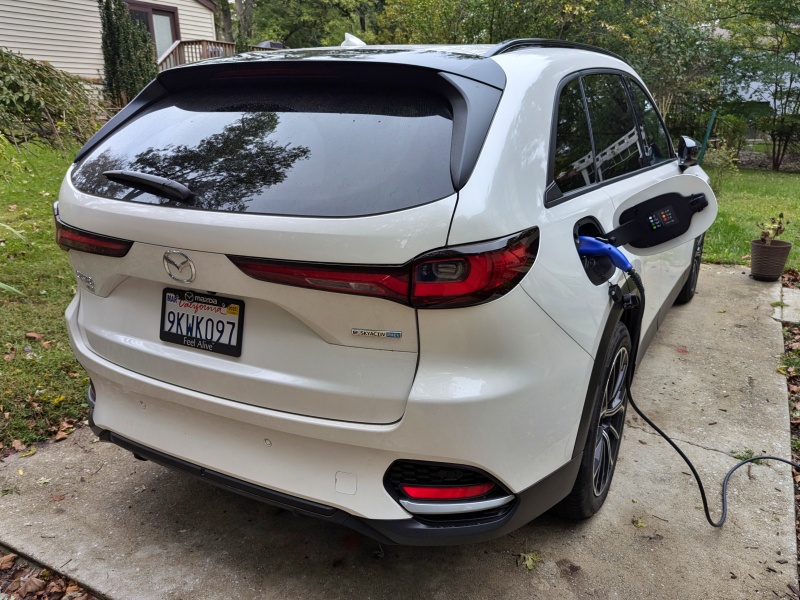
2025 Mazda CX-70 PHEV ・ Photo by Brady Holt
Beautifully Finished Interior
Continuing the CX-70’s premium vibe, the Mazda’s dashboard is beautifully finished with rich materials and well-fitting trim pieces. Both our test vehicles were in the top Premium Plus configuration, with Nappa leather and an available suede-trimmed dashboard. They’re richer than many luxury-brand crossovers. But even the base models look and feel upscale.
When you’re looking for simple functionality or high-tech dazzle, the CX-70 is less amazing. The competitively sized 12.3-inch infotainment display lacks touchscreen capabilities (except when using Apple CarPlay or Android Auto), forcing you to use a scroll wheel and other physical controls located between the front seats. The graphics aren’t luxury-car crisp, and the screen can only show limited amounts of information at a time. Meanwhile, with small cupholders and a shallow center-console bin, the CX-70’s interior designers didn’t make cabin storage into a top priority. Still, while it’s not for everyone, this Mazda makes an undeniably upscale impression overall.
The CX-70’s interior design is nearly identical to the CX-90’s, but only the former offers the red upholstery pictured on our PHEV test vehicle.
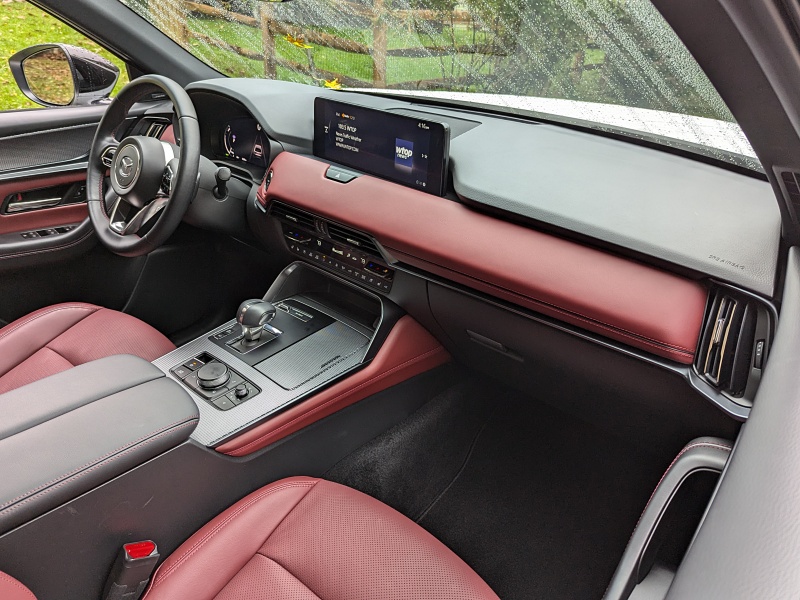
2025 Mazda CX-70 PHEV ・ Photo by Brady Holt
Comfortable Seating for Five
The Mazda CX-90 fits in a third-row seat that can be useful for children or, in a pinch, cooperative adults. The CX-70 takes away that option – its biggest difference from the CX-90. What you get instead is spacious seating for up to five passengers. Ironically, this gives you perhaps more passenger capacity than CX-90 trim levels that only include second-row captain’s chairs; that’s because with their third rows folded, they only have four seats.
The CX-70’s seats are comfortable in the front and the rear. The rear seats can adjust fore-aft to maximize either cargo space or second-row legroom. A Volkswagen Atlas Cross Sport has even more stretch-out space in the back, but the CX-70 otherwise beats most two-row crossovers.
Even the base CX-70 Preferred, $40,445, includes leather upholstery, heated front seats, tri-zone automatic climate control, and second-row sunshades – typically extra-cost amenities at this price range. However, you need the Premium Plus ($49,400) for ventilated front seats, a power passenger seat, a heated steering wheel, or heated rear seats. And unlike on the CX-90, ventilated second-row seats aren’t available on the CX-70.
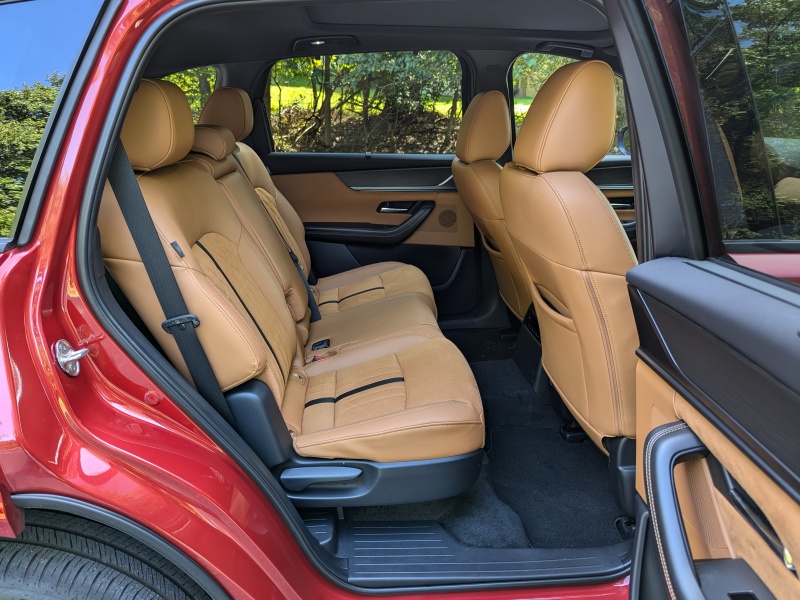
2025 Mazda CX-70 Turbo S ・ Photo by Brady Holt
Useful Cargo Hold
The three-row Mazda CX-90 doesn’t have much cargo room with its third row in use, about 15 cubic feet. So most owners will likely keep it folded down a significant portion of the time. The CX-70 offers similar space that’s always available: 40 cubic feet behind the second row and 75 cubic feet behind the front seats. That’s better than most two-row crossovers – reflecting the fact that the CX-70 is the size of a three-row model.
The CX-70’s one cargo advantage over the CX-90 is a small covered cubby under the cargo floor. It’s in the area where the CX-90 has a third-row footwell, which means it’s not easy to reach from outside the car. The cubby is also crafted from low-grade foam.
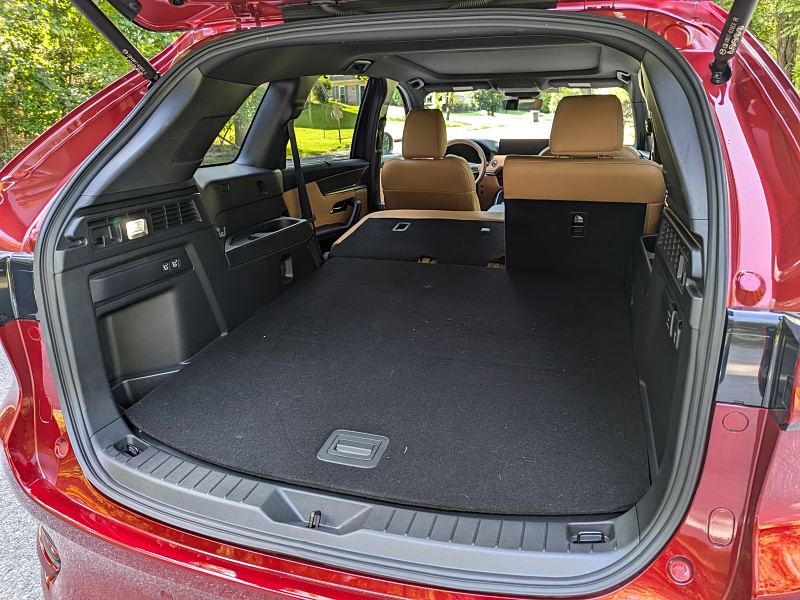
2025 Mazda CX-70 Turbo S ・ Photo by Brady Holt
Upscale Alternatives
Mazda has made a mid-size SUV that feels far more luxurious and fun to drive than mainstream-brand rivals, all while offering ample space and competitive prices – at least on the base 280-hp engine.
We’d happily shop it against luxury-brand crossovers as well. Unless you prefer a compact size, it’s a roomier, more powerful, better-equipped alternative to a compact Acura RDX or Infiniti QX50 – or the best-selling mid-size Lexus RX. And if you’re looking for space and luxury, the CX-70 drives better than a Mercedes-Benz GLE-Class and isn’t far behind a BMW X5 – both of which have starting prices above $60,000. Their infotainment systems are more sophisticated than Mazda’s, but if that’s not a top selling point and you aren’t focused on the badge, you should be stopping by your Mazda dealership.
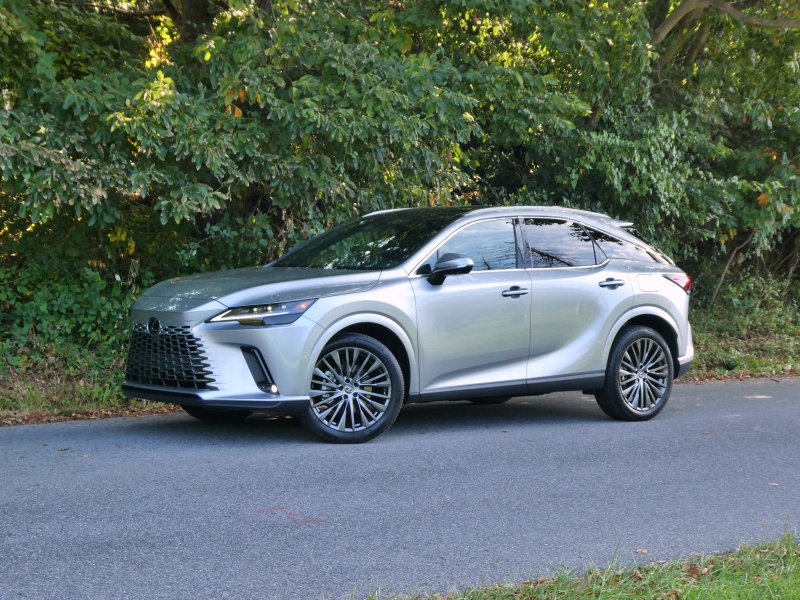
2023 Lexus RX 350h ・ Photo by Brady Holt
And Yet, It Makes Little Sense
Perhaps you’ve spent this review wondering, “Well, why wouldn’t I just get a Mazda CX-90 and fold down the rear seat?” Good question. We share it. The two SUVs look the same, cost the same, and are nearly identical in most ways.
Fortunately, both of them are excellent choices for someone who values premium-grade style and performance. And if you find a great deal on a CX-70 and don’t need a third-row seat, you can score an even better price on a crossover that already offers a lot for the money.
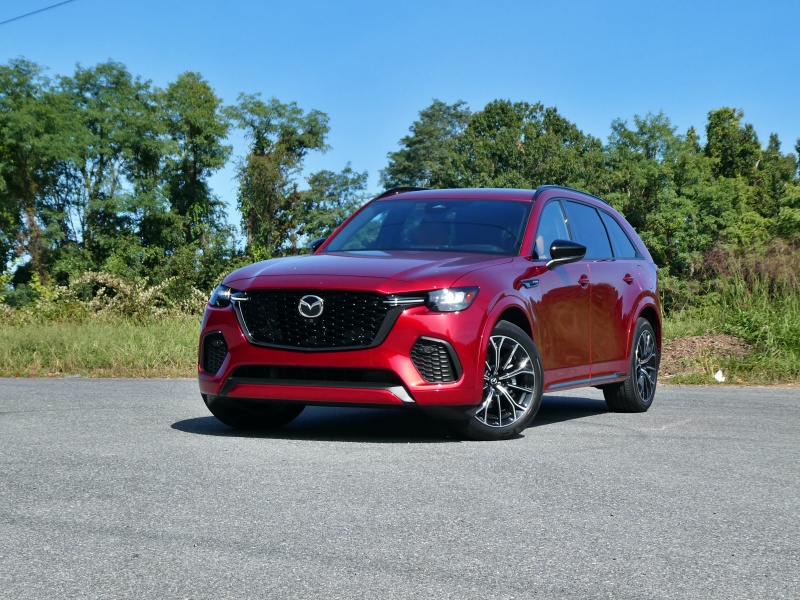
2025 Mazda CX-70 Turbo S ・ Photo by Brady Holt